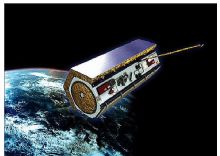PAZ (Spanish for “Peace”) is a Spanish radar technology satellite designed to address not only security and defence requirements, but also others of civilian nature.HISDESAT is the owner and operator of the satellite. PAZ was launched on the 22nd of February 2018 from the Vandenberg Air Base in California, using the SpaceX Falcon 9 rocket
It is capable of daily taking more than 100 images of up to 25 cm resolution, both day and night, and independently of weather conditions. It cover an area of over 300,000 square kilometers a day, and orbit the Earth fifteen times a day at an altitude of 514 kilometers and a speed of seven kilometers per second. Thanks to its slightly inclined quasi-polar orbit, PAZ cover the entire Earth with an average revisit time of 24 hours.
PAZ provides Earth Observation capabilities for multiple purposes: border control, intelligence, environmental monitoring, protection of natural resources, military operations, enforcement of international treaties, surface monitoring, city and infrastructure planning, monitoring of natural catastrophes and high-resolution mapping, among many others.
The satellite features a ground-configurable electronic radar able to work in different modes combining resolution and image size. PAZ was designed to work in five different modes:
- spotlight (with up to 1 metre resolution and covering areas of 5 x 5km),
- stripmap (up to 3 metres and areas of 30 x 50km),
- scansar (for areas of 100 x 150km and resolutions of 18.5 metres),
as well as two additional modes now being developed:
- the ultra high resolution (up to 25cm)
- staring spotlight, and wide swathe scanradar covering areas of 270 x 200km

In 2012, Hisdesat signed an agreement with Airbus Defence and Space (formerly Astrium GEO Services) for the creation of a constellation of radar satellites that would use in a coordinated manner the resources that PAZ, TerraSAR-X and TanDEM-X make available to customers.
For more information :https://www.hisdesat.es/en/paz/
PAZ TECHNICAL SPECIFICATIONS:
|
Operational life |
7 years |
|
Orbit |
Sun-synchronous repeat orbit |
|
Orbits / day |
15 2/11 |
|
Repeat period |
11 days |
|
Nominal orbit height at the equator |
514 Km |
|
Inclination |
97.44° |
|
SAR instrument |
|
|
Radar carrier frequency |
9.65 GHz |
|
Chirp bandwidth |
100 MHz, 150 MHz, 300 MHz |
|
Antenna type |
Active phased array antenna |
|
Antenna size |
4.8 m length, 0.7 m width |
|
Polarizations |
HH, HV, VV, VH |
|
PRF |
2.0 KHz – 6.5 KHz |
|
Nominal acquisition direction |
Right looking |
|
Number of elevation beams in StripMap |
27 for SM-S 54 for SM-D |
|
Number of elevation beams in ScanSAR |
14 |
|
Number of elevation beams in Spotlight & HR Spotlight |
122 |
|
Number of azimuth beams |
115 |
